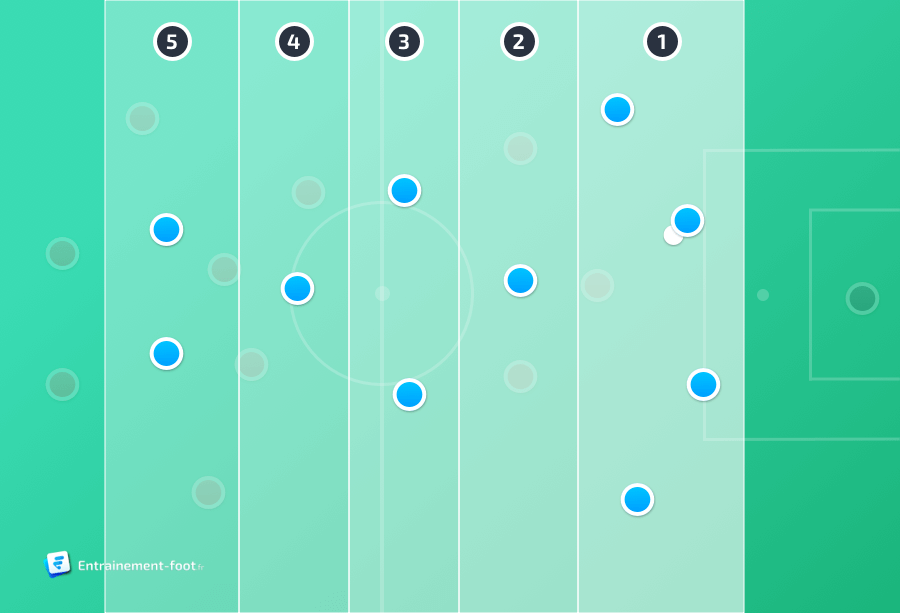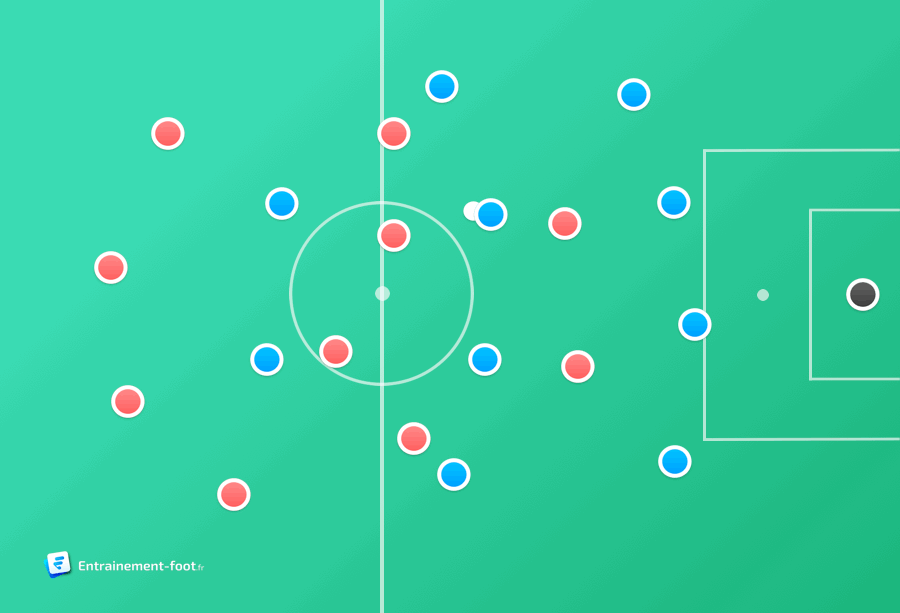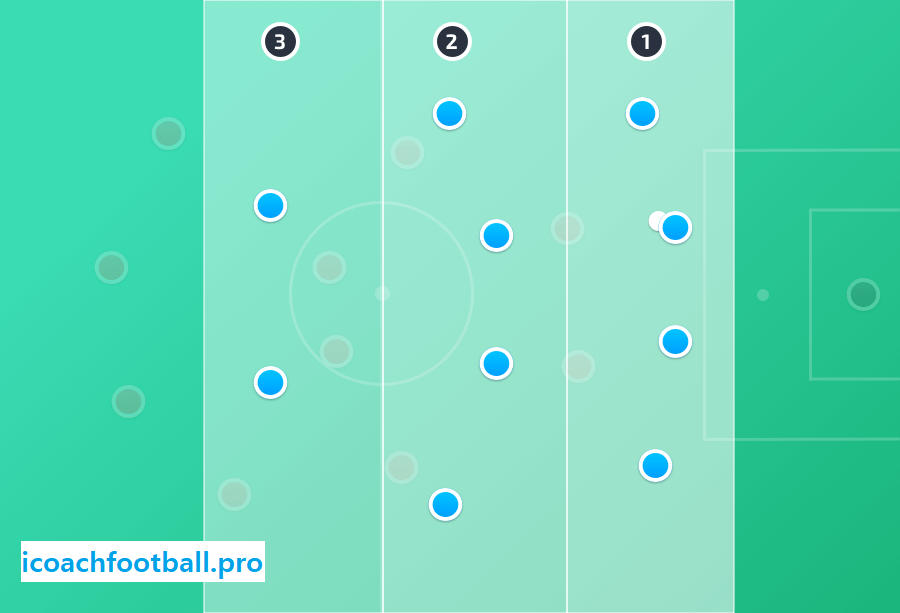Table of Contents
- 1 What is 4-4-2 formation in football & tactical variations
- 2 How to play well in 4-4-2? Tactics Guide
- 3 How to position yourself defensively in a 4-4-2 formation?
- 4 The strengths of a 4-4-2 formation
- 5 4-4-2 weak points
- 6 General and position-orientated tactical tasks in the 4-4-2 formation
- 7 4-4-2 with a midfield diamond
- 8 4-4-2 with flat four
- 9 Advantages of the 4-4-2 with a midfield diamond
- 10 Disadvantages of the 4-4-2 with a midfield diamond
- 11 Advantages of the 4-4-2 with flat four
- 12 Disadvantages of the 4-4-2 with flat four
- 13 The 4-4-2 system with flat four in detailed information (with comments on the diamond) Defensive formation:
Discover the strengths and weaknesses of the 4-4-2 with our comprehensive guide. From offensive animation, through defensive placement, whether it’s a flat 4-4-2 or a diamond, everything is covered in our complete guide to one of the most famous formations in the world of football.
The 4-4-2, whether flat or diamond, is an essential in the coach’s tactical toolbox. It is widely used, both in the professional and amateur world. What is a 4-4-2 tactic? How to set it up? What are the advantages and disadvantages of 4-4-2? Discover our complete guide.
What is 4-4-2 formation in football & tactical variations
The 4-4-2 is a very common tactic in football which consists of positioning 4 defenders, 4 midfielders and 2 attackers. The 4-4-2 formation is therefore made up of 3 very distinct lines.
A 4-4-2 formation can generally be presented in 2 different ways : the flat 4-4-2 (or classic) and the 4-4-2 diamond . Let’s detail these 2 tactics together to fully understand their objectives.
The flat 4-4-2
The flat (or classic) 4-4-2 is the basic formation, which will allow you to align 4 defenders, 4 flat midfielders then 2 attackers . This is a very well-known formation and one that most players are familiar with:
- A line of 4 defenders
- A line of 4 flat midfielders
- A line of 2 attackers
Very simple to set up, it does not require any particular skills and does not put too much pressure on your 4 environments. Here’s how a flat 4-4-2 formation breaks down .

The different lines of 4-4-2
The 4-4-2 in a diamond
The second derivative of the classic 4-4-2 is the diamond 4-4-2. It generally consists of three lines, including 4 flat defenders, 4 midfielders forming a diamond (this is what gave it its name) and finally a line of 2 attackers .
To be completely precise, the 4-4-2 diamond is not really composed of 3 lines, but rather of 5 lines:
- A line of 4 defenders
- A defensive midfielder (low point)
- Two relay midfielders
- A central attacking midfielder (high point)
- And finally, two attackers

The different lines of the 4-4-2 diamond, box to box midfielders.
To find out more, visit our detailed article on the advantages and disadvantages of a 4-4-2 diamond tactic .
How to play well in 4-4-2? Tactics Guide
What offensive animation in 4-4-2?
In a flat 4-4-2 formation, it is important to note the essential role of the 2 central midfielders . They will have to be present defensively in front of the defense but also be the driving forces in the offensive phases of play.
So consider combining 2 complementary player profiles in these positions: a predominantly defensive player, and a 2nd player who is more comfortable with the ball, with a “relay” type profile.
This notion of “relayed” is a key notion in a 4-4-2 tactic. Whether you play flat or in a diamond, the relay midfielders will be key in your offensive animation. As their name suggests, relay midfielders carry out the relay between the defensive and offensive phases .
This is why they are a key ingredient of the 4-4-2 . They will have to regularly provide passing solutions to their defenders (and to their defensive midfielder in the case of a 4-4-2 diamond), while being attentive to the lanes during defensive phases.

The role of the torchbearers in 4-4-2
How to position yourself defensively in a 4-4-2 formation?
The flat 4-4-2 is a formation which will emphasize defensive solidity above all else. With these 2 lines of 4 defenders and 4 midfielders, it will create 2 real defensive curtains in front of your goal.
To simplify, there are 2 ways to defend with a 4-4-2 formation:
- You can set up a middle block , which will allow you not to take too many risks, knowing that your players will be close to each other.
- You can apply a high defensive block , with constant pressing from your 2 attackers, followed by the 4 midfielders. So remember to work on your defensive-offensive transitions .
Regarding the 4-4-2 diamond (or diamond) you will surely experience a large number of crosses, because you will voluntarily concentrate your formation around a central axis (central defenders, defensive midfielder, attacking midfielder) .
This is why, as with many other formations such as 4-3-3 , 3-4-3 or even 3-5-2 , it is important that your central defenders have good heading skills.
The strengths of a 4-4-2 formation
The first big strength of a 4-4-2 tactic is the overall solidity it offers. With a line of 4 defenders, a line of 4 flat midfielders and 2 attackers, you can be sure that each player will always be covered by one of their teammates.
In addition, you will be able to field up to 4 attackers during the offensive phases, with the contribution of the 2 full-backs, and/or the splitting of your full-backs.

The creation of 4 attackers during the offensive phases
Finally, as we saw above, the 4-4-2, whether flat or diamond, will allow you to set up a high defensive block. You will then block the opponent’s short restarts, and will be able to give instructions around counter-pressing (or gegenpressing) to put pressure on your opponents as soon as the ball is lost.
4-4-2 weak points
The great weakness of a 4-4-2 formation is the risk for your opponents of finding themselves too easily between the lines, particularly between the line of 4 midfielders and 4 defenders. You will have to ask your players to communicate well in order to reach an agreement between your central defenders and your 2 defensive midfielders.
The second weak point that you will have to keep in mind is the fact that the offensive phases could be easily predictable by your opponents. A 4-4-2 formation generally leaves little room for offensive improvisation , hence the importance of asking your players to create a surprise by stalling or changing zone quite often.
General and position-orientated tactical tasks in the 4-4-2 formation
The 4-4-2 formation defines the number of players in the individual parts of the team. The goalkeeper is excluded from this. In this formation, with four defensive players, four midfielders and two strikers, the coach is given more variations to adapt, which in each case can be distinguished from each other by the positioning of the midfielders.
Tactically much more can be involved than merely sending the players onto the field in a certain formation. It is the coach’s (and club’s) philosophy of how to play and the available qualities of the players that are the deciding factors that determine how a formation will ultimately be tactically implemented on the playing field.
The 4-4-2 formation thereby represents one of a number of possibilities. Through the different ways and means of positioning players on the pitch, six to seven sections with many triangle formations and play-to points emerge for each offensive structure.
In the defensive unit, three to four sections are formed depending on the chosen defensive formation. The two most common variations of the 4-4-2 formation are the 4-4-2 diamond formation and the 4-4-2 linear formation with a so-called “flat four”. Both of these will now be introduced with their most important characteristics. The focus will be on the most commonly used formation with the flat four.
4-4-2 with a midfield diamond
In the diamond formation, a chain of four defenders, a defensive central midfielder, two players in the halfback positions, an attacking central anchorman midfielder and two strikers are played. The main focus is put on attacking play through the middle.
4-4-2 with flat four
In this system, there is no anchorman behind the strikers. The subdivision of the four available midfielders takes place with two defensively oriented players in the halfback positions and two offensively oriented players on the flanks. The positioning of the set of defenders and strikers conforms to that which was described in the diamond formation. The main focus is put on closing the space in front of the team’s own defense.
Advantages of the 4-4-2 with a midfield diamond
• Creative attacking play through central, offensive midfielders
• The emergence of a situation in attack where the opposition’s defense is outnumbered
• Strengthened attacking play through the middle
• Strengthened integration with the strikers
• Increased passing possibilities through the formation of triangles between players
Moving the left back and right back farther up the field when in possession of the ball and positioning the two strikers staggered in a deep lying position establishes seven (playing) sections in the attacking play with a triangular positioning of the players. This leads to a higher number of passing options.
Disadvantages of the 4-4-2 with a midfield diamond
• Susceptibility to quick counter attacks through the middle (only one defensively orientated central midfielder).
• Free space on the flanks in the area between the wingback and the midfielders in the half-back position.
• Increased susceptibility to attacking plays down the wings, as the wingbacks in this formation must be attack oriented.
Advantages of the 4-4-2 with flat four
• Concentrated safeguarding in the center of midfield courtesy of the two central defensive midfielders.
• Strengthened play down the flanks when in possession of the ball through the offensive orientation of the two wide midfielders.
• The flanks are occupied without the wingbacks having to move completely forward (defensive cover guaranteed). The flanks are doubly occupied so outnumbering the opposition can be accomplished easier or crosses can be played.
• Owing to greater open space between the attack and the center of midfield, the strikers can be played in these open areas and consequently a defender can be drawn out of the defense, or the wide midfielders have the opportunity here to cut inside by dribbling the ball.
Disadvantages of the 4-4-2 with flat four
• Due to the offensive orientation of the two wide midfielders, free space/situations where the team is outnumbered by the opposition come about through quick counterattacks by the opposition.
• There is no central attacking midfielder, and therefore also no additional, creative player who can play passes from the middle into the deeper positions or who can storm into the middle with a dribble.
As a result, the opportunity to create direct shots on goal from such plays is lost, along with the opportunity to create open space for the attackers and wide midfielders.
• Large areas of open space in the area between the attack and central midfield.
• In the attacking formation, there are fewer different sections of play as a result of the two attacking wingbacks and staggered strikers than in the diamond formation. Hence only six points to play exists versus the diamond formation.
The 4-4-2 system with flat four in detailed information (with comments on the diamond) Defensive formation:
When the opposition has possession of the ball the team in the defensive unit should form the 4-4-2 linear formation in a maximum area of 35 x 35 meters. The defensive formation distinguishes its basic positioning via a linear positioning of the separate parts of the team. This means both the four defenders as well as the four midfielders and two strikers are positioned at a certain level. They therefore form 3 defensive lines.
At the same time it is necessary for them to maintain a certain distance from each other, which guarantees an optimal defense of the team’s goal. This distance as a general rule is as follows: 7-12 meters across and 8-15 meters in depth. The distance between the individual players and parts of the team can vary as a result of an erratic playing speed, change in the playing conditions or when the team’s full complement of players is temporarily reduced.
Discover below 4-4-2 system in PDF
Whether you want to set up a flat 4-4-2 , a 4-4-2 diamond or even a 4-2-3-1 tactic , don’t forget to adapt your playing system to the inherent qualities to your players. Depending on your workforce, you will be able to choose the training that suits best, so there is no need to force things.
Finally, don’t forget that the tactical aspect is also part of the pleasure of playing , it is not a constraint. Share your passion with your players, give them as many instructions as possible and always explain the why behind your tactical choices . Happy coaching!

